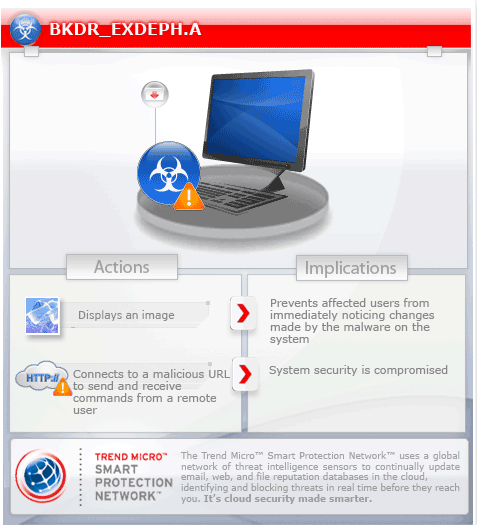BKDR_EXDEPH.A
Windows 2000, Windows XP, Windows Server 2003


Threat Type: Backdoor
Destructiveness: No
Encrypted: No
In the wild: Yes
OVERVIEW
This backdoor is related to the spammed message about the Gaddafi Death picture.
To get a one-glance comprehensive view of the behavior of this Backdoor, refer to the Threat Diagram shown below.

Upon execution, this backdoor drops and opens a .JPG file to trick users into thinking that the executed file is legitimate and to hide its execution in the background. It contains a picture of Gaddafi.
This backdoor arrives as an attachment to email messages spammed by other malware/grayware or malicious users.
It opens a hidden Internet Explorer window. However, as of this writing, the said sites are inaccessible.
TECHNICAL DETAILS
Varies
EXE
Yes
25 Oct 2011
Connects to URLs/IPs, Opens Internet Explorer window
Arrival Details
This backdoor arrives as an attachment to email messages spammed by other malware/grayware or malicious users.
Installation
This backdoor drops the following component file(s):
- %User Temp%\explorer.exe - also detected as BKDR_EXDEPH.A
- %Program Files%\WindowsUpdate\winupdate.exe.exe - also detected as BKDR_EXDEPH.A
(Note: %User Temp% is the current user's Temp folder, which is usually C:\Documents and Settings\{user name}\Local Settings\Temp on Windows 2000, XP, and Server 2003.. %Program Files% is the default Program Files folder, usually C:\Program Files.)
Autostart Technique
This backdoor adds the following registry entries to enable its automatic execution at every system startup:
HKEY_CURRENT_USER\Software\Microsoft\
Windows\CurrentVersion\Run
update = "{Malware Path and File Name}"
HKEY_CURRENT_USER\Software\Microsoft\
Windows\CurrentVersion\Run
WindowsUpdate = "%Program Files%\WindowsUpdate\winupdate.exe.exe"
HKEY_LOCAL_MACHINE\SOFTWARE\Microsoft\
Active Setup\Installed Components\{L2YPI760-53VH-1121-351O-EL7076Y0V6C2}
StubPath = "%Program Files%\WindowsUpdate\winupdate.exe.exe Restart"
HKEY_LOCAL_MACHINE\SOFTWARE\Microsoft\
Windows\CurrentVersion\Run
update = "{Malware Path and File Name}"
HKEY_LOCAL_MACHINE\SOFTWARE\Microsoft\
Windows\CurrentVersion\Run
WindowsUpdate = "%Program Files%\WindowsUpdate\winupdate.exe.exe"
Other System Modifications
This backdoor adds the following registry entries as part of its installation routine:
HKEY_CURRENT_USER\Software\$GADAHFI$
FirstExecution = "{HEX Values}"
HKEY_CURRENT_USER\Software\$GADAHFI$
FileName = "{HEX Values}"
HKEY_CURRENT_USER\Software\$GADAHFI$
HKLM = "{HEX Values}"
HKEY_CURRENT_USER\Software\$GADAHFI$
HKCU = "{HEX Values}"
HKEY_CURRENT_USER\Software\Cerberus
StartPersist = "{HEX Values}"
Backdoor Routine
This backdoor opens the following port(s) where it listens for remote commands:
- TCP 8521
It opens a hidden Internet Explorer window.
It connects to the following URL(s) to send and receive commands from a remote malicious user:
- {BLOCKED}ne.{BLOCKED}pto.org
However, as of this writing, the said sites are inaccessible.
NOTES:
Upon execution, this backdoor drops and opens the following .JPG file to trick users into thinking that the executed file is legitimate and to hide its execution in the background:
- %System Root%\Gaddafi.jpg
The said .JPG file contains the following picture of Gaddafi:
SOLUTION
9.200
8.520.07
26 Oct 2011
8.521.00
26 Oct 2011
Step 1
For Windows XP and Windows Server 2003 users, before doing any scans, please make sure you disable System Restore to allow full scanning of your computer.
Step 2
Restart in Safe Mode
Step 3
Delete this registry value
Important: Editing the Windows Registry incorrectly can lead to irreversible system malfunction. Please do this step only if you know how or you can ask assistance from your system administrator. Else, check this Microsoft article first before modifying your computer's registry.
- In HKEY_CURRENT_USER\Software\Microsoft\Windows\CurrentVersion\Run
- update = "{Malware Path and File Name}"
- update = "{Malware Path and File Name}"
- In HKEY_CURRENT_USER\Software\Microsoft\Windows\CurrentVersion\Run
- WindowsUpdate = "%Program Files%\WindowsUpdate\winupdate.exe.exe"
- WindowsUpdate = "%Program Files%\WindowsUpdate\winupdate.exe.exe"
- In HKEY_LOCAL_MACHINE\SOFTWARE\Microsoft\Windows\CurrentVersion\Run
- update = "{Malware Path and File Name}"
- update = "{Malware Path and File Name}"
- In HKEY_LOCAL_MACHINE\SOFTWARE\Microsoft\Windows\CurrentVersion\Run
- WindowsUpdate = "%Program Files%\WindowsUpdate\winupdate.exe.exe"
- WindowsUpdate = "%Program Files%\WindowsUpdate\winupdate.exe.exe"
Step 4
Delete this registry key
Important: Editing the Windows Registry incorrectly can lead to irreversible system malfunction. Please do this step only if you know how or you can ask assistance from your system administrator. Else, check this Microsoft article first before modifying your computer's registry.
- In HKEY_CURRENT_USER\Software
- $GADAHFI$
- $GADAHFI$
- In HKEY_CURRENT_USER\Software
- Cerberus
- Cerberus
- In HKEY_LOCAL_MACHINE\SOFTWARE\Microsoft\Active Setup\Installed Components
- {L2YPI760-53VH-1121-351O-EL7076Y0V6C2}
- {L2YPI760-53VH-1121-351O-EL7076Y0V6C2}
Step 5
Restart in normal mode and scan your computer with your Trend Micro product for files detected as BKDR_EXDEPH.A. If the detected files have already been cleaned, deleted, or quarantined by your Trend Micro product, no further step is required. You may opt to simply delete the quarantined files. Please check this Knowledge Base page for more information.
Did this description help? Tell us how we did.



